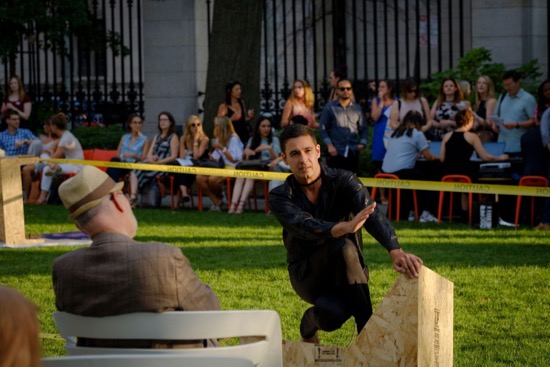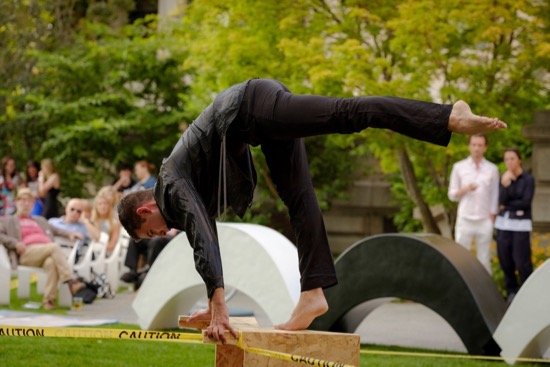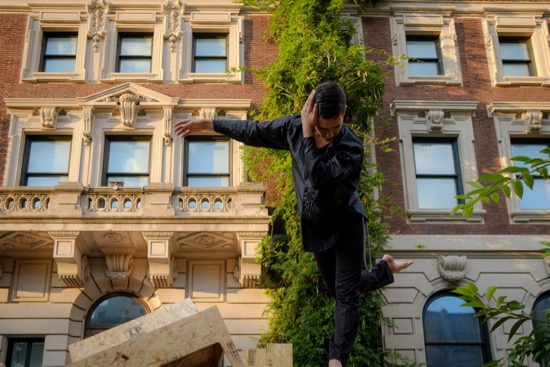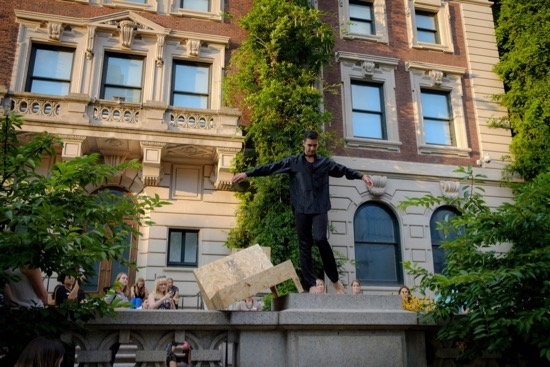Jonah Bokaer Choreography at the Cooper Hewitt, Smithsonian Design Museum.

Jonah Bokaer and watcher in his The Disappearance Portraits. © Dreaded Photo
August 24, 2017. It’s one of Manhattan’s best summer days—hot enough to encourage many of its citizens to don amazingly skimpy outfits, but graced by a balmy breeze. This is the last day that Jonah Bokaer performs site-specific solos in the garden of the Cooper Hewitt, Smithsonian Design Museum. I’m disoriented from the start, having arrived at 6:45 P.M. for a performance that I’d been informed would start at 7:00, and learned that it had started fifteen minutes ago. The orange plastic chairs on three sides of the lawn are all occupied. A colleague I haven’t seen in ages offers to buy me a beer from a refreshment stand. I accept. A couple right in front of me vacates its chairs (a stroke of luck). We sit, me sipping, between two critics (one of them my ex-editor). And all this time, I’m watching Bokaer dancing, while also glancing at the laughing Asian toddler intoxicated with running free, but always returning to her mother and sister on the grass. Her voyage doesn’t rank with that of Ulysses slowly making his way home to Ithaca, but it’s a voyage nonetheless.
I bring up Ulysses, because I think I’m seeing the second of the three works grouped together as The Disappearance Portraits; it’s called “The Ulysses Syndrome.” In my mind I link the area that’s cordoned off by waist-high yellow CAUTION tape with a ship, although it’s not exactly shaped like one. The tape is anchored to square-edged, variously proportioned composite-board islands, designed by artist Chris Rucker. Bokaer is wearing black; his jacket gleams in the sunlight, and a few long, thin loops (by designers Steven & William) dangle from it (I wrote “jangle” in my notes, so perhaps they made a noise?). I’ve begun to be aware of sounds not made by the spectators—voices whispering, hooting, a gong that suggests waves crashing—but recordings by the Soundwalk Collective.

Jonah Bokaer in the garden of the Cooper Hewitt, Smithsonian Design Museum. © Dreaded Photo
Bokaer is very precise in his movements and constantly alert to his surroundings. He has to be. As he slowly feels his way along a sculpture of linked black-and-white shapes by Walter Hood, two women picnicking and chatting on the grass right beside it are not much interested in him, nor do they consider getting out of his way. He, unperturbed, crawls through one of the openings in the artwork and continues his voyage.
Now that I’ve connected him to Ulysses, I’ve started making up stories that he’s not really telling. He appears at times to be chewing something. . .what can that mean? He picks up and hauls on a rope attached to a sculpted ring. He hangs over one of the composite-board objects, and I think of the railing of a deck. He stands on another, scans the horizon, and slowly raises an arm. Now something both fortuitous and eerie happens. As if a strong wind has suddenly sprung up, the yellow tapes start to vibrate and make crackling noises. Just as suddenly, they stop. Balancing on one leg, Bokaer swims his arms in the air. On another box, he holds his hands low in front of him, as if they were text he was studying (I stop myself from over-interpreting it as a map). Once, he assumes a heroic stance and seems to aim and draw an unseen bow.
A smattering of applause may mean that this solo is over, and Bokaer, now on the high balcony that extends along one side of the Cooper Hewitt, bows. He doesn’t stop though, only pauses, and beginnings and endings begin to slur around in my mind. I look at my program. It’s a sheet of paper, folded in three, and one side of it holds a design made of carefully arranged photographs, the size of a fingernail or tinier, some of them repeated many times. They are blurry mages of people or of one person, mostly posed outdoors (members of Bokaer’s Middle Eastern family, I’m later told). I look up. Caroline Baumann, Director of the Cooper Hewitt, wearing a gleaming bronze cocktail dress, chases her roaming, blond-haired little boy. Are they going to a party when this is over? I look down at the program again.

Jonah Bokaer in his The Disappearance Project. © Dreaded Photo
“Bessarabia Ghost Tapes,” the supposed second part of The Disappearance Portraits, is supposed to start at 8:00, but I think it starts almost immediately. This time, the Soundwalk Collective’s contribution (courtesy of DOCUMENTA14) is identified as “2013 Sound Files: Atrocities in Bessarabia (Vanished Region: Now Moldova/Ukraine.)” And here we are in a garden, drinking beer and feeling the sun on our skins.
The Soundwalk Collective (Stephan Crasneanscki, Simone Merli, and Kamran Sadeghi) defines its approach to composition as combining “anthropology, ethnography, non-narrative, psycho geography, the observation of nature, and explorations in recording and synthesis.” Its members travel. They do field work. Bessarabia—once part of the Turkish Empire, squabbled over, taken over, given back, renamed. Several days later, I remember another piece, also named The Ulysses Syndrome, which Bokaer premiered in 2013 at the FIAF World Nomads Festival. It was a duet with his father, Tsvi Bokaer, who had left his native Tunisia and wandered and worked in Europe and America before settling in a new-world Ithaca in upstate New York and raising a family. So my memory of what I saw in the garden begins to jostle against themes of discovery and rediscovery, homecomings and assumption of new identities, travels and losses along the way. Bokaer has done his own share of traveling, beginning when he was a member of Merce Cunningham’s company and continuing in his artistic relationship with Robert Wilson.
But what I’m seeing at the Cooper Hewitt is the residue of voyages: a man—elegant, enigmatic, and beautifully composed—dances in a garden, and I can hardly take my eyes off him. I want to know what he’s thinking and recalling. In “Bessarabia Ghost Tapes,” he embarks on another kind of mission from that of Ulysses. Part of the time he disappears, unless I rise from my orange chair and climb the stairs to watch him standing on a plinth, hovering near a doorway. Seen from below—he’s hidden in foliage, concealed by more strange furniture-like structures, then comes into view again on a plinth. He stands beside a bush, plucking leaves and casting them down to the lawn below. A blurry, suspicious, authoritarian voice in Soundwalk Collective’s soundscape demands, “Why are you coming here?”

Jonah Bokaer on the balcony railing of the Cooper Hewitt, Smithsonian Design Museum. © Dreaded Photo
I find Bokaer again beyond the perimeters of the taped area. Is it my imagination, or have his gestures speeded up and loosened a little? He’s not doing a lot of footwork on this small mound covered with creeping plants. Movements that I think I’ve seen earlier in the evening look more intense at close range. He repeats some of them over and over, wanting us to see them, understand them. Many times, he brushes his hand around and over his head. Pulling up a concealing hood? Or nothing so literal. Using both hands to smooth a sheaf of paper? Or nothing so literal. Doing what he has to do. Then, suddenly he’s done. He bows; we applaud.
The disparity between the darkness lurking behind this work and its pleasant, convivial setting is unsettling. Perhaps that was part of Bokaer’s plan. I walk down 5th Avenue, admiring the huge old trees that flank Central Park, happy to have spent a summer evening watching fine dancing, and thankful that I have a home and family to which I can return.

Sounds extremely uncomfortable on many levels, but there is nothing uncomfortable about reading your fluid description of the action and wise assessment of the dances.
“Now that I’ve connected him to Ulysses, I’ve started making up stories that he’s not really telling. ” Always a danger in this line of work — human beings want things to make sense, and we’ll keep working away at it until it does. This is how philosophy gets made, and dance criticism as well.
Still Here. Still reading your fabulous reviews. FD in Houston.